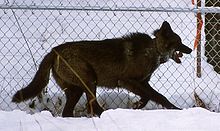As the name implies, the Wolf Hybrid also known as the Wolf dog is a cross breed between a dog and a wolf (typically a grey wolf).
Consequently, Wolf-dog hybrids are a mixture of genetic traits resulting in less predictable behavior patterns compared to either the wolf or dog.
Wolf-dog hybrid (hybrid for short) is a term used to describe an animal that is part wolf and part domestic dog. Dogs (Canis lupus familiaris) and wolves (Canis lupus) share an evolutionary past and thus share many physical and behavioral traits.
Dogs evolved from wolves through a centuries-long process of domestication. Domestication is the process by which a wild animal adapts to living with humans by being selectively bred by humans over thousands of years. Through this process, a dog’s behavior, life cycle and physiology have become permanently altered from that of a wolf.
Wolves and dogs are interfertile, meaning they can breed and produce viable offspring. In other words, wolves can interbreed with any type of dog, and their offspring are capable of producing offspring themselves. Although hybrids can occur naturally in the wild, they are rare because the territorial nature of wolves leads them to protect their home ranges from intruding canines such as dogs, coyotes and other wolves.
HISTORY
Whole genome sequencing has been used to study gene flow between wild and domestic species. There is evidence of widespread gene-flow from dogs into wolf populations, and very few deliberate crossings of wolves with dogs, such as the Sarloos wolfdog. However, the global dog population forms a genetic cluster with little evidence for gene flow from wolves into dogs. Ancient DNA shows that dogs from Europe over 5,000 years ago also show little evidence of interbreeding with wild canids.
Prehistoric wolfdogs
A 1982 study of canine skulls from Wyoming dating back 10,000 years ago identified some that match the morphology of wolfdogs.This study was rebutted as not providing convincing evidence four years later.
Teotihuacan wolfdogs
In 2010, archeologists announced that they had found the remains of wolf-dogs that had been kept by the warrior class of the Teotihuacan civilization in Mexico's central valley about two thousand years ago, and that, in light of this finding, certain animals commonly depicted in the art of that culture, which had been thought to be strange dogs or coyotes, are being re-examined.
New World black wolves
Genetic research from the Stanford University School of Medicine and the University of California, Los Angeles revealed that wolves with black pelts owe their distinctive coloration to a mutation that entered the wolf population through admixture with the dog. Adolph Murie was among the first wolf biologists to speculate that the wide color variation in wolves was due to interbreeding with dogs.


No comments:
Post a Comment